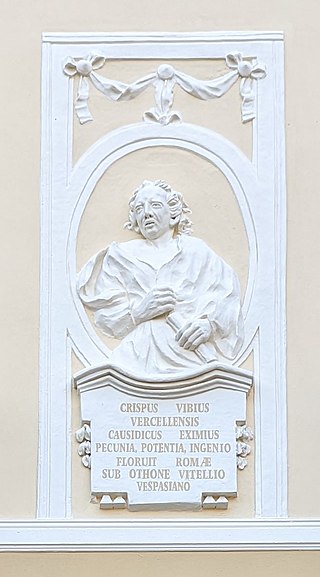Related Research Articles

Gallia Lugdunensis was a province of the Roman Empire in what is now the modern country of France, part of the Celtic territory of Gaul formerly known as Celtica. It is named after its capital Lugdunum, possibly Roman Europe's major city west of Italy, and a major imperial mint. Outside Lugdunum was the Sanctuary of the Three Gauls, where representatives met to celebrate the cult of Rome and Augustus.
Marcus Arrecinus Clemens, was a prefect of the Praetorian Guard during the reign of Vespasian. In return for his faithful service, Clemens was promoted to other important positions, including being twice consul and urban prefect of Rome.
Gaius Julius Cornutus Tertullus was a Roman senator who was active during the late 1st and early 2nd centuries. He is best known as the older friend of Pliny the Younger, with whom Cornutus was suffect consul for the nundinium of September to October 100.

Lucius Junius Quintus Vibius Crispus was a Roman senator and amicus or companion of the Emperors, known for his wit. He was a three-time suffect consul.
Sextus Vettulenus Cerialis was a Roman senator and military commander, the 1st legate of Judaea. He was an early supporter of Vespasian, who appointed Cerialis suffect consul in either 72 or 73.
Gaius Antius Aulus Julius Quadratus was a Roman senator from Pergamon, who was appointed consul twice, in AD 94 and then in AD 105, the first senator from the Eastern Mediterranean to achieve the ordinary consulship.
Lucius Tettius Julianus was a Roman general who held a number of imperial appointments during the Flavian dynasty. He was suffect consul for the nundinium of May–June 83 with Terentius Strabo Erucius Homullus as his colleague.
Gaius Laecanius Bassus Caecina Paetus was a Roman senator of the early Roman Empire, whose known career flourished under the reign of Vespasian. He was suffect consul in the nundinium of November to December AD 70 as the colleague of Lucius Annius Bassus.

Lucius Funisulanus Vettonianus was a Roman general and senator during the reigns of the Flavian emperors. He was suffect consul in the nundinium of September to October 78 with Quintus Corellius Rufus as his colleague.
The gens Minicia was a plebeian family at ancient Rome. Members of this gens are first mentioned in the first century, achieving the consulate under the emperor Claudius. Owing to the similarity of their names, the Minicii are regularly confused with members of the ancient and far more prominent gens Minucia.
Marcus Cornelius Nigrinus Curiatius Maternus was a Roman senator and general during the reign of Domitian. He was suffect consul during the nundinium of September to October AD 83 with Lucius Calventius Sextius Carminius Vetus. Although some experts consider him a rival with Trajan as heir apparent to the emperor Nerva, he is primarily known from inscriptions.

Quintus Julius Cordinus Gaius Rutilius Gallicus was a Roman senator who held several posts in the emperor's service. He was twice suffect consul: for the first time in the nundinium of September to October 70 AD; and the second time in 85 with Lucius Valerius Catullus Messalinus as his colleague, succeeding the Emperor Domitian.
Gaius Calpetanus Rantius Quirinalis Valerius Festus was a Roman senator, general, and amicus to each of the Flavian emperors. He proved his value to the Flavians when, as legatus legionis, or commander, of Legio III Augusta stationed in Africa, he assassinated the proconsul, who favored a rival of Vespasian during the Year of Four Emperors. He maintained his loyalty through the reigns of his sons Titus and Domitian, but fell out of favor during the latter's reign and was forced to commit suicide.
Lucius Neratius Priscus was a Roman senator who held several posts in the emperor's service. He was suffect consul for the nundinium September–December AD 87 as the colleague of Gaius Cilnius Proculus. Priscus is known almost entirely from inscriptions recovered from Saepinum.

Quintus Pomponius Rufus was a Roman senator active in the imperial service; he was governor during the reigns of the emperors Domitian and Trajan. Rufus was also suffect consul for the nundinium September-December AD 95 as the colleague of Lucius Baebius Tullus. Pomponius Rufus is known primarily from inscriptions.
Publius Nonius Asprenas Caesius Cassianus was a Roman senator who was active in the first century. He was appointed suffect consul by Vespasian in either 72 or 73. Cassianus is known only through inscriptions. He is identified as the son of Publius Nonius Asprenas Calpurnius Serranus, ordinary consul of 38.
Marcus Pompeius Macrinus Neos Theophanes was a Roman senator of the second century who held several imperial appointments. He was suffect consul during the nundinium of September to December 115 with Titus Vibius Varus as his colleague. Older writers like Ronald Syme had dated his career some fifteen years earlier, but subsequent research confirmed a later date. Macrinus is primarily known from inscriptions.
Lucius Luscius Ocrea was Roman senator of the first century. He was suffect consul in either the years 77 or 78. Ocrea is primarily known from inscriptions.

Titus Atilius Rufus was a Roman senator, who held several appointments during the reigns of Nero, Vespasian and Domitian. He was suffect consul in some nundinium prior to the year 80. He is known primarily from inscriptions.
References
- ↑ Werner Eck, Senatoren von Vespasian bis Hadrian (München: Beck'sche, 1970), p. 105
- ↑ Eck, "Jahres- und Provinzialfasten der senatorischen Statthalter von 69/70 bis 138/139", Chiron , 12 (1982), p. 302 and note
- ↑ Eck, "Jahres- und Provinzialfasten", pp. 304-306
- ↑ Paul Gallivan, "The Fasti for A. D. 70–96", Classical Quarterly , 31 (1981), pp. 190, 197, 216
- ↑ Eck, "Jahres- und Provinzialfasten", p. 330
- ↑ CIL XI, 1147